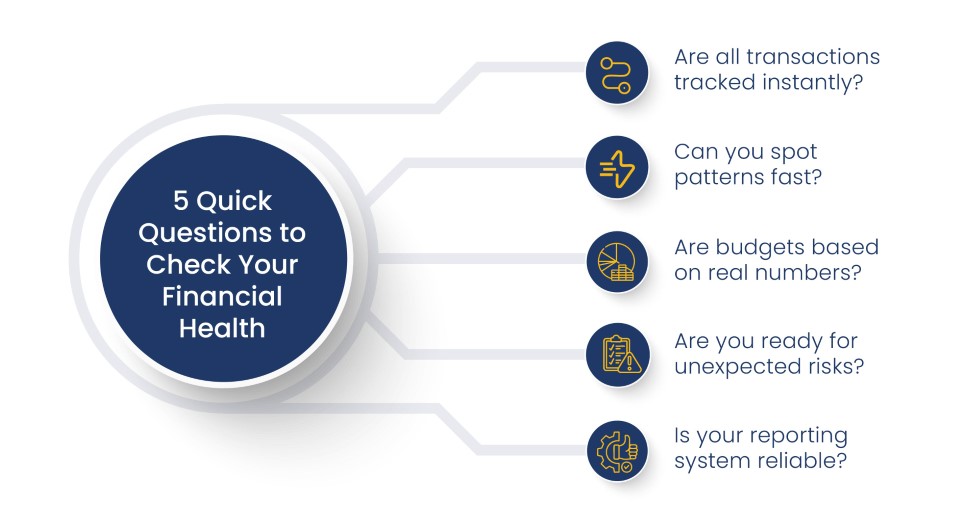Every business decision, from daily spending to long-term investments, depends on one core factor: financial clarity. This financial clarity is gained from financial reporting. It is the process of taking a complete record of financial spending and analyzing how money moves in and out of a company. When reports are generated accurately and in a timely manner, leaders come forward with clarity to make sound choices that are backed by data. When they lag, it will be difficult to track and manage the organisation’s finances.
This is why real-time financial reporting has become a game-changer. Instead of waiting for end-of-month reconciliations or quarterly updates, companies can now access live data to act immediately. Driving this shift is modern accounting software, which automates reporting, cuts down on delays, and gives businesses confidence in the numbers they rely on.
Financial Reporting – What It Means for Your Business
Definition & Purpose of Financial Reporting
At its core, financial reporting is all about keeping a close track of income, expenses, and performance. It gives a brief idea to the business owners and managers about where the money is coming from, how it is being used, and whether it is being spent right to achieve the company’s goal. Having reports like profit and loss statements or balance sheets assists in the process of decision-making and reveals the financial story of a business.
Traditional vs Real-Time Reporting
The old way of reporting was built around a cycle basis. It used to be about generating reports on a monthly, quarterly, or annual basis. While this system worked, it had a clear drawback: the reports always reflected past financial activities rather than the present ones.
As these results reflected the data from the past, rectifying issues like overspending or declining revenue was too late. Real-time reporting solves this by providing a continuous flow of updated data. This tends to allow companies to respond quickly while situations are still unfolding.
Role of Accounting Software
Trying to achieve real-time visibility without technology is nearly impossible. Accounting software centralizes all kinds of financial information, automates calculations, and delivers reports quickly without taking days. It acts as the single source of a report generation platform for all types of financial data, ensuring accuracy and removing the inefficiencies of manual tracking.
How Real-Time Financial Reporting Improves Decision Making
Faster, Informed Decisions
When every number is current, leaders can act quickly without second-guessing. For instance, a business considering a bulk purchase can instantly check whether there’s enough cash flow to support the expense. This speed not only saves time but also sharpens the business’ competitive edge.
Identifying Trends & Risks Early
Patterns in sales, expenses, or cash flow often signal bigger opportunities—or problems—on the horizon. Real-time financial reporting allows businesses to notice these signals before they escalate. Spotting rising costs early helps curb waste, while identifying strong-performing products enables smarter investment.
Better Budgeting and Forecasting
Plans based on outdated data are little more than guesses. By using up-to-date financial information, companies can build budgets and forecasts that are grounded in reality. This makes it easier to prepare for seasonal demand, allocate resources efficiently, and maintain stability even during uncertain times.
Businesses using outdated accounting systems often face delays in reporting. Learn more about whether it’s time to upgrade in our guide: 5 Signs It’s Time for Your Business to Upgrade to Accounting Software.
Key Features of Accounting Software That Support Real-Time Financial Reporting
Automated Data Entry
More than being a monotonous process, manual data entry also has certain risk factors. Even a small, misplaced decimal or duplicated entry can distort the entire report. Accounting software manages to eliminate these issues by recording transactions automatically, saving time and improving reliability.
Real-Time Dashboards and Reports
Numbers are more useful when they’re easy to understand. The core functionality of the dashboard is to transform and present raw data into visuals that highlight trends, cash flow positions, and profitability at a very quick glance. This tends to make even the complex financial information easier to understand and more accessible to non-finance leaders as well.
Integration Across Departments
Finance doesn’t exist in isolation. It is connected to HR, sales, inventory, and operations. Accounting software extracts data from all these areas into one single platform. This ensures that the decisions are well structured and made by gaining a complete picture rather than fragmented insights.
Here are 5 Quick Questions to Check Your Financial Health:

Conclusion
In today’s business environment, real-time financial reporting plays a vital role in achieving overall growth. Organizations that step further to embrace it are better equipped to respond quickly, manage risks effectively, and plan with better clarity with regard to the financial part of the business. Investing in the right accounting software gives detailed financial data, guiding every decision with clarity and confidence that is made in the organization.
If you find that your current reporting process feels slow or incomplete, now is the right time to consider using an accounting software. By opting for the right tools, you empower your team to make confident decisions and keep your business moving forward with certainty!

